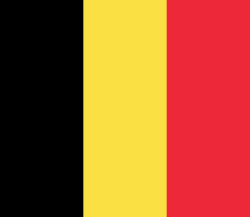Le drapeau belge
Le drapeau belge ("The Belgian Flag") is a recitation with orchestral accompaniment written by the English composer Edward Elgar as his Op. 79, in 1917. The words are by the Belgian poet Émile Cammaerts. The poem reflects on the wartime meaning of the colours of the Belgian flag.
It was first performed at the birthday concert for King Albert I in the Queen's Hall, London, on 14 April 1917, with the recitation by Belgian dramatic performer Carlo Liten,[1] and the orchestra conducted by Hamilton Harty.
On 15 August 1918, Le drapeau belge and Carillon were performed with success at a popular concert in Prospect Park, Brooklyn, with the recitations by Carlo Liten.[2]
Lyrics
The original words were in French, and an English translation was provided by Lord Curzon of Kedleston.
|
Français LE DRAPEAU BELGE 1.
2.
3.
|
English THE BELGIAN FLAG 1.
2.
3.
|
Recordings
- Elgar: War Music Richard Pascoe (narrator), Barry Collett (conductor), Rutland Sinfonia
References
- Kennedy, Michael, Portrait of Elgar (Oxford University Press, 1968) ISBN 0-19-315414-5
- Moore, Jerrold N. “Edward Elgar: a creative life” (Oxford University Press, 1984) ISBN 0-19-315447-1
Notes
- ↑ Carlo Liten was born in 1879 in Antwerp, Belgium of a Belgian father and Italian mother. He was a distinguished theatre actor and reciter, at the time well-known in Europe and America. He performed in Elgar's Carillon, Le drapeau belge and Une voix dans le désert. After World War I he acted in three films "The Strongest" (1920), "L'Affaire du train" (1921) and "Les Mystères de Paris" (1922). It was said of him by John Palmer (assistant editor of the London Saturday Review) that Liten "had the most wonderful voice in the memory of any living person ... for resonance, serviceableness and charm the most remarkable I have ever heard from any actor. Add to this mastery of gesture and expression dictated by a refined intelligence and we get a rare personality."
- ↑ Pay Belgium Tribute in Brooklyn concert
